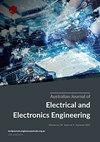Feature level fusion framework for multimodal biometric system based on CCA with SVM classifier and cosine similarity measure
Q3 Engineering
Australian Journal of Electrical and Electronics Engineering
Pub Date : 2022-10-03
DOI:10.1080/1448837X.2022.2129147
引用次数: 2
Abstract
ABSTRACT The multimodal biometric system using feature level fusion offers more accurate and reliable recognition performance than the unimodal system. But in practice, feature level fusion is challenging to perform when biometric modalities have heterogeneous and incompatible feature representation and enforce the final decision more confidently. One of the main concerns in the fusion of features is to drive the highly discriminatory representation amongst different biometric modalities. This paper aims to design a framework for an efficient feature level fusion based on canonical correlation analysis (CCA) with a support vector machine (SVM) classifier to get a highly discriminant and affine invariant fused feature vector. The principal component analysis (PCA) + CCA subspace approach is used to achieve dimensionality reduction and feature fusion in a coherent manner, This approach eliminates the need for a complex matcher/classifier design to process a fused feature vector and also reduces computational complexity. The experimental findings for the SDUMLA-HMT multimodal database demonstrate that CCA on the extracted feature sets of iris and fingerprint modalities results in reasonably better multimodal classification accuracy with a substantial reduction in the feature dimensions. Using SVM, we achieved a classification accuracy of 100%. In this paper furthermore, three different distance measures are explored to test the efficacy of the proposed CCA-based feature level fusion approach. The best recognition performance is achieved in terms of an equal error rate (EER) of 0.176% for the cosine similarity measure. We also compared the proposed approach with the match score level fusion method. The proposed feature level fusion approach excels the recognition performance in contrast to the other literature approaches.基于支持向量机分类器和余弦相似度测度的CCA多模态生物特征融合框架
采用特征级融合的多模态生物识别系统比单模态系统具有更准确、更可靠的识别性能。但在实践中,当生物识别模式具有异质和不兼容的特征表示时,特征级融合很难实现,并且难以更自信地执行最终决策。特征融合的主要问题之一是驱动不同生物识别模式之间的高度歧视性表示。本文旨在设计一种基于典型相关分析(CCA)和支持向量机(SVM)分类器的高效特征级融合框架,以获得高度判别和仿射不变的融合特征向量。采用主成分分析(PCA) + CCA子空间方法以连贯的方式实现降维和特征融合,该方法消除了复杂的匹配器/分类器设计来处理融合的特征向量的需要,也降低了计算复杂度。SDUMLA-HMT多模态数据库的实验结果表明,对提取的虹膜和指纹模态特征集进行CCA,可以获得较好的多模态分类精度,特征维数大幅降低。使用SVM,我们实现了100%的分类准确率。此外,本文还探索了三种不同的距离度量来测试所提出的基于ca的特征级融合方法的有效性。余弦相似性度量的等错误率(EER)为0.176%,达到了最佳识别性能。并将该方法与匹配分数水平融合方法进行了比较。与其他文献方法相比,所提出的特征级融合方法具有更好的识别性能。
本文章由计算机程序翻译,如有差异,请以英文原文为准。
求助全文
约1分钟内获得全文
求助全文
来源期刊

Australian Journal of Electrical and Electronics Engineering
Engineering-Electrical and Electronic Engineering
CiteScore
2.30
自引率
0.00%
发文量
46
期刊介绍:
Engineers Australia journal and conference papers.
 求助内容:
求助内容: 应助结果提醒方式:
应助结果提醒方式:


